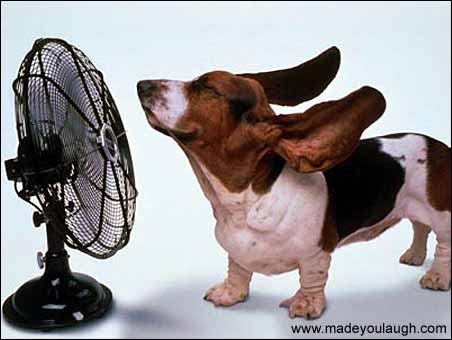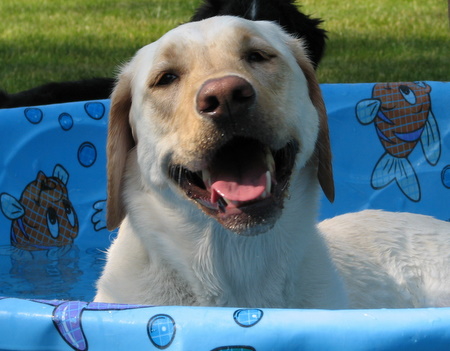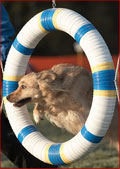The Dog Days Of Summer Are Approaching, Would You Know If Your Dog Is Having A Heat Related Emergency?
Below are a couple of heat related emergencies that all dog owners (ESPECIALLY those involved in high activity dog sports) should be aware of. Remember, after initial care has been provided in case of an emergency you MUST contact your veterinarian for advice on further treatment.
Heat Stroke
Caring pet owners already know how dangerous it is to leave their dogs in the car. However, leaving pets outdoors or in hot, unventilated, indoor places on hot summer days can also be extremely dangerous. What people forget is that their dogs cannot handle the heat the same as humans do. Dogs do not have sweat glands as humans do, except for a few on their feet. They do not perspire and can only rid their bodies of heat by panting, which is not enough when the temperature soars.
This is especially true with brachycephalic (dogs with short, flattened noses), such as Boxers, Bulldogs, Boston Terriers, Lhasa Apsos, Shih Tzus, Pekinese, etc. And animals’ fur coats retain heat, making warm temperatures even more uncomfortable. This can cause them to suffer more quickly from heat stress. Dogs with heavy coats, heart or respiratory troubles, those who are exercising too much in the heat, as well as overweight, very young, infant, and elderly dogs all need special consideration in the heat and have a greater likelihood of developing heat stroke. Heat stroke occurs when normal body mechanisms cannot keep the body's temperature in a safe range.
HEAT STROKE SYMPTOMS INCLUDE:
*A rapid or erratic heartbeat/pulse
*Rapid breathing, or struggling for breath
*Exaggerated panting, or the sudden stopping of panting
*Increased, excessive, loud, heaving, irregular panting or the sudden stopping of panting
*A very high body temperature - usually, cell damage begins to occur at body temperatures over 106 degrees
*Excessive drooling, or frothing at the mouth
*Dark red gums
*Vomiting
*Barking or whining
*Anxiety or agitation
*Dizziness
*Confusion
*Incoordination - stumbling and/or trouble standing or walking
*An anxious, vacant, or staring expression
*Listlessness or weakness
*Shaking or seizures
*Collapse or unconsciousness
Other signs of heat stroke can include some or all of the following:
*Dry mouth and nose
*Lack of urine production
*Weakness and muscle tremors
*Dryness and redness (or dull grayish-pink or blue) of the inside of the tongue, mouth, lips and gums and gums - OR -
*Drooling and excess salivation
*Glazed eyes and/or dilated pupils
*Difficulty standing or walking
*Vomiting and/or diarrhea
Animals showing these signs need immediate medical treatment, so take the dog to a veterinarian or animal emergency room as soon as possible. If your pet starts to retch and vomit, this can be a sign that the body temperature is reaching 109 degrees Fahrenheit. Soon after, the dog will go into shock, followed by possible seizures and a loss of consciousness. These are all serious signs and the dog must see a veterinarian immediately. This is an EMERGENCY! Even at the earliest stage of heat stroke, you may be fighting for your dog's life. If not treated immediately, these symptoms can be followed in minutes by collapse, seizures, coma, and death. You must get your pup to a veterinarian as soon as possible. If untreated, SEVERE HYPERTHERMIA (heat stroke) results in kidney, liver and/or heart failure. Dogs who are treated after a significant delay may survive, but could be left with permanent effects such as blood clotting disorders, metabolic abnormalities, muscle damage, and/or brain dysfunction, etc.
WHAT TO DO:
This is a life threatening situation and needs immediate veterinarian attention. There are a few things you can do if your vet has to call you back or on the way to the veterinarian's office or emergency room:
1) Immediately move the dog to a cooler area. Place the dog in a shady area or put a large umbrella over him/her.
2) Offer the pup small amounts of water (too much water may cause the dog to vomit and add to your pet’s dehydration).
3) If the dog will not drink of his/her own accord, then wipe the mouth area with a clean, wet cloth.
4) Sponge down the whole body, including tummy and groin area with COOL, not cold water. Cold water will cause blood vessels to constrict and will stop the heat from escaping. This could send your dog into shock from the sudden drop in body temperature. NEVER throw buckets of water over the dog, or throw him/her into cold water, as these actions will almost certainly put the dog into shock, making the situation far worse than it already is!
5) If you do not have an electric fan, improvise one with a towel or something that will cause a draft around the wet dog; however, do not do anything that might panic him/her unnecessarily. Fanning the dog will help to cool him/her through the process of evaporation. If the dog has collapsed, continue with the above steps until professional help arrives. Be prepared to carry out cardiopulmonary resuscitation (CPR) should it  become necessary. The dog needs electrolyte replacement and oral replacement is not sufficient. The electrolytes need to be replaced through intravenous (IV) administration.
become necessary. The dog needs electrolyte replacement and oral replacement is not sufficient. The electrolytes need to be replaced through intravenous (IV) administration.
REMEMBER, AN OUNCE OF PREVENTION IS WORTH A POUND OF CURE IN THE CASE OF HEAT STROKE.
DO NOT TAKE CHANCES IN HOT WEATHER. IT IS NOT WORTH THE RISK!!!
Heat Exhaustion
Heat Exhaustion occurs with exercise, particularly on hot, humid days. The symptoms are similar to those of heat stroke, but may not be associated with an elevation in body temperature, as is the case with heat stroke.
HEAT EXHAUSTION SYMPTOMS INCLUDE:
*Heavy panting
*Dog begins huffing and puffing or gasping for air
*Dog begins to weave when s/he walks because of dizziness
*Dog lies down or collapses and cannot get up
*Dog becomes unconscious
*Collapse or fainting
*Mentally dazed
*Vomiting
*Muscle cramps (seizure-like tremors)
*Abnormally rapid heartbeat and rapid breathing
*Muscle weakness
WHAT TO DO:
Depending on the seriousness of the situation, these are the steps an owner should take if his/her dog is suffering from heat exhaustion:
1) Move the dog out of the sun and into the shade or into an air-conditioned building or follow the instructions for shading the dog, as directed above in "Heat Stroke."
2) Give the dog water to drink, but do NOT allow the dog to drink copious amounts.
3) Rinse the dog off with cool water, either in the bath tub or with a garden hose.
4) Place the dog in front of a fan while still damp.
5) Place ice bags around the dog's head and neck. You may also apply them to the groin area for rapid blood cooling.
6) Take the dog to the veterinarian only after the dog has been cooled down. Take your dog's temperature; this should be done rectally to get the most accurate reading.
7) Prepare your dog for transport to the nearest emergency animal clinic. Do NOT cover your dog, even with a cold towel. A towel will prevent the heat from escaping. A cold washcloth on the tummy is fine.
From:canine-epilepsy-guardian-angels.com

 dog care,
dog care,  dog first aid,
dog first aid,  heat related emergencies,
heat related emergencies,  sport dog in
sport dog in  First Aid
First Aid 





Reader Comments (1)
Great information, I will share the link with all of my friends who are dog owners!!